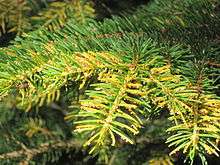Chrysomyxa
Chrysomyxa is a genus of rust fungi in the family Coleosporiaceae. The genus, widespread in the Northern Hemisphere, contains about 23 species.[1] Rust fungi in the genus Chrysomyxa occur in boreal forests of the northern hemisphere on Pinaceae, (mostly Picea), and most species alternate to angiosperm hosts in the Ericaceae.[2]
| Chrysomyxa | |
|---|---|
 | |
| Chrysomyxa rhododendri on Norway spruce | |
| Scientific classification | |
| Kingdom: | Fungi |
| Division: | Basidiomycota |
| Class: | Pucciniomycetes |
| Order: | Pucciniales |
| Family: | Coleosporiaceae |
| Genus: | Chrysomyxa Unger (1840) |
| Type species | |
| Chrysomyxa abietis | |
| Species | |
|
See text | |
| Synonyms | |
Species
- Chrysomyxa abietis
- Chrysomyxa arctostaphyli
- Chrysomyxa cassandrae
- Chrysomyxa chiogenis
- Chrysomyxa diebuensis[3]
- Chrysomyxa empetri
- Chrysomyxa expansa
- Chrysomyxa himalensis
- Chrysomyxa ledi
- Chrysomyxa ledicola
- Chrysomyxa nagodhii
- Chrysomyxa neoglandulosi
- Chrysomyxa piperiana
- Chrysomyxa pirolata
- Chrysomyxa pyrolae
- Chrysomyxa reticulata
- Chrysomyxa rhododendri
- Chrysomyxa roanensis
- Chrysomyxa stilbae
- Chrysomyxa succinea
- Chrysomyxa vaccinii
- Chrysomyxa weirii
- Chrysomyxa woroninii
- Chrysomyxa zhuoniensis[3]
gollark: Arduino C also isn't.
gollark: That is a use.
gollark: "Functions" aren't actual mathematical functions so strange functional programmers insist on distinguishing them.
gollark: 🌵 C O R OU T INE 🌵
gollark: unfortunately you'll have the issue of not knowing the content underneath it.
References
- Kirk PM, Cannon PF, Minter DW, Stalpers JA (2008). Dictionary of the Fungi (10th ed.). Wallingford, UK: CABI. pp. 140–1. ISBN 978-0-85199-826-8.
- Crane, P.E. 2001. Morphology, taxonomy, and nomenclature of the Chrysomyxa ledi complex and related rust fungi on spruce and Ericaceae in North America and Europe. Can. J. Bot. 79:957–982.
- Cao, Jing; Tian, Chengming; Liang, Yingmei; You, Chongjuan (2017). "Two new Chrysomyxa rust species on the endemic plant, Picea asperata in western China, and expanded description of C. succinea". Phytotaxa. 292 (3): 218–230. doi:10.11646/phytotaxa.292.3.2. ISSN 1179-3163.
This article is issued from Wikipedia. The text is licensed under Creative Commons - Attribution - Sharealike. Additional terms may apply for the media files.